People who saved 1968
Surely you are familiar with the Christmas (Christmas) stories - beautiful stories, often with a fantastic element and always a good ending. And in the history of cosmonautics there is a mission, when in a dark year three people set off on a flight on Christmas, which became a great joy for the whole world. 50 years ago, Frank Borman, Jim Lowell, William Anders, and 400,000 people employed in the Apollo program saved the year 1968.

Apollo 8 in Moon Orbit, 3D NASA

Wounded during the Tet offensive, the American marines, photo by John Olson
1968 from the outset did not ask. In late January, the Vietnam War escalated - the Tet offensive led to the death, according to various sources, of 50-100 thousand people, of whom about 14 thousand were civilians. In March, a massacre took place in the village of Songmi, which will become widely known a year later. In May, the government of Charles de Gaulle resigned as a result of the social crisis in France and the ten-million general strike. In the US, Martin Luther King and Robert Kennedy were killed as a result of the attempted assassination. In August, the USSR sent troops to Czechoslovakia. The Cultural Revolution was ending in China - now they were fighting with the Red Guards.
In the space sphere, matters were also so-so. Both the USA and the USSR were retreating from the catastrophes of 1967, the death of Vladimir Komarov, Gus Grissom, Edward White and Roger Chaffee. On March 27, 1968, a new tragedy occurred - the first cosmonaut Yuri Gagarin died in a training flight. At the same time, the moon race reached its peak. In the first half of the year in the United States conducted unmanned tests of the lunar module (Apollo 5) and the second test of the launch vehicle Saturn V (Apollo 6). The USSR responded in part by successfully launching the Zond-4 unmanned flyby of the moon. In September, the Zond-5 successfully flew around the moon, and there were chances that suddenly Soviet cosmonauts would end up on the trajectory to the moon. NASA needed to do something.
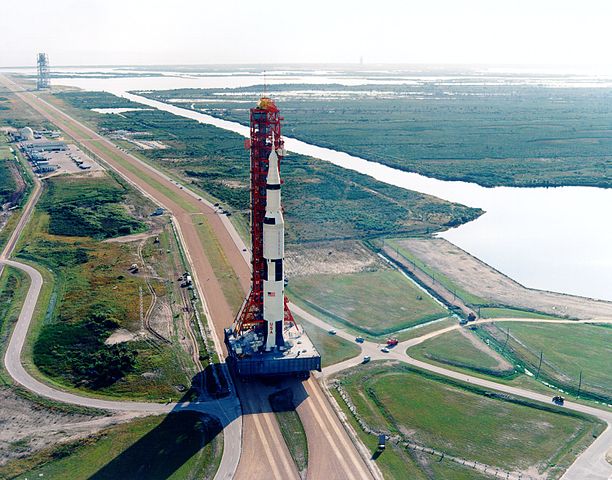
Removal of Apollo 8 at the start, October 1968
According to the original plan, after Apollo unmanned tests, they were to be tested in flight with the crew in near-earth orbit. Further missions depended on the readiness of the lunar module - in the initial plan they wanted to test him first in near-earth orbit, then in elliptical, then in orbit of the moon, and, finally, the next mission was to be landing on the moon. But in the summer of 1968, it turned out that there were more than a hundred bugs in the lunar module, and until next year he could not fly. Therefore, NASA decided to risk and maneuver missions. The tests of the command module in the near-earth orbit, Apollo 7, already scheduled for October, cannot be moved anywhere. If the lunar module is not ready, its manned tests in near-earth orbit (Apollo-9) will have to be shifted. But the next command module was expected as early as December, and it became possible to replace the tests of the lunar module in an elliptical orbit around the Earth with a manned flight to the Moon without a lunar module, but with access to the lunar orbit. In addition to the political goal of overtaking the USSR, this mission was also useful for the test program. So in August 1968 was born "Apollo-8". But one more problem had to be solved.
The second tests of the Apollo-6 launch vehicle did not go very smoothly. In the area of the first stage, longitudinal oscillations (also known as “pogo”) arose; in the second stage, first one and then the second engine was disconnected. Without the elimination of these problems, it was impossible to fly anywhere. By August, hydraulic dampers were added to the design of the first stage, removing vibrations, and in the second stage, the pilot fuel tube was modified and the wires were shortened so that they could not be confused. The changes were successfully tested on the ground and checked in flight on the Apollo 7 in October. You could fly.
The ship and the rocket were assembled in September, brought to launch in October, and fixed minor problems until December.
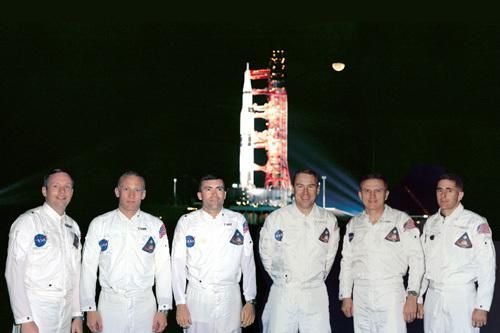
Photo NASA
Now fun to look at the main and reserve crews of the Apollo 8. In the main crew (right) Lowell, Borman and Anders, in the reserve (left) - Armstrong, Aldrin and Hayes. On the Apollo 11, the situation will be reversed - mainly the crew of Armstrong, Aldrin, Collins, in the reserve - Lowell, Anders and Hayes. Fred Haze will then fly to Apollo 13 with Lowell.
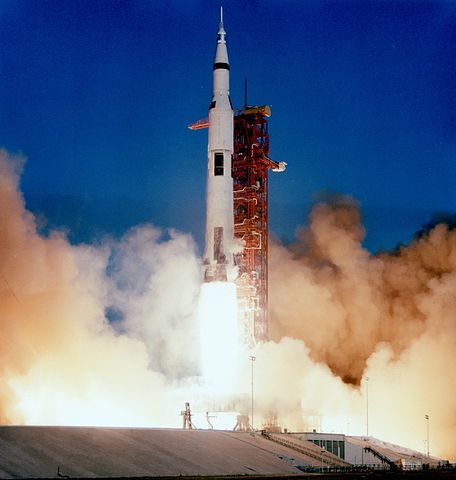
NASA Photos
Apollo 8 was launched at 12:51 UTC on December 21, 1968. After a minute, the rocket overcame the speed of sound. According to the astronauts, commander Frank Borman removed his hand from the handle of the manual activation of the emergency rescue system - the rocket shook so that he decided to die rather than cause a false CAC response. However, the start was without comment. After 2 minutes 34 seconds, the first stage began, the second stage worked until 08:44. The third stage engine came on at 08:48 and worked until 11:25. The ship went into orbit. By the end of the second hour of the flight, the ship's systems checked, and at 15:41 UTC (02:50:37 AM) the third stage engine started up again. Five minutes later, the Apollo 8 went to the moon.
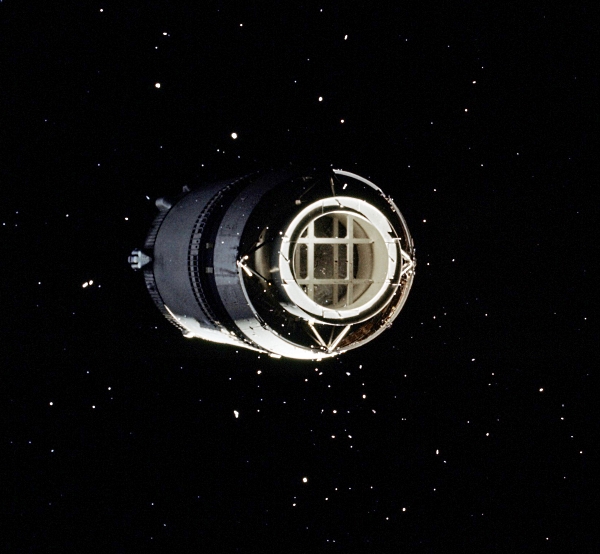
NASA Photos
After separation from the third stage, the “full-fledged” Apollo had to turn around and dock with the lunar module. The Apollo-8 had a mass-dimensional mock-up of the lunar module, but this didn’t stop practicing - turn the ship around and take a picture of the third stage with an adapter.

The photo was supposedly taken by Anders.
Having traveled only 10% of the distance to the moon, the astronauts could already feel the main lesson of space - scale. The earth was now located entirely in the porthole, and for the first time, people saw with their own eyes how it was shrinking.
In general, things were going well, but it was not without problems. First of all, the beginning of the nauseous crew commander, Frank Borman. The cosmic adaptation syndrome is a perfectly normal thing, and now about 33-66% of the crew suffers, but, of course, there is a slight panic on the part of the medics. Someone even thought to recall the mission, but the ballistics was inexorable - the Apollo flew to the Moon. Part of the second problem can be seen in the photo of the third step above - the pieces of ice along with other debris pretended to be stars and seriously hampered the work on determining the position of the ship.
On December 24, Apollo 8 arrived at the moon. And it was waiting for a new critical operation - the transition to the lunar orbit. According to the laws of ballistics, the maneuver had to be carried out on the far side of the moon, out of sight of the Earth. The ship went behind the disk of the moon, the connection with it disappeared, and the control center held its breath. If the ship appeared earlier, it would mean that he could not perform the maneuver. It would not be scary - "Apollo 8" before the maneuver was on the trajectory of returning to Earth. But every second of delay would be deadly - in the maneuver performed for the first time there was quite a chance in case of an error to crash into the moon. The maneuver was successful. And in the third orbit, astronauts noticed a new beauty - the Earth, which ascended over the lunar horizon. They first made a black and white photo, then frantically rushed to look for a color film.

But the reconstruction, in which the position of the ship in space is restored by automatically taking photographs of a fixed camera.
In the lunar orbit, Apollo 8 completed a maneuver to go into a circular orbit of 110 km, the astronauts took many photos, experimented with observing training landing sites, and conducted two more live broadcasts (two were already on the way to the Moon). But the world remembered the fourth broadcast, at 87 hours of flight and 18 hours of being in the Moon’s orbit. Even before the flight, astronauts knew that they would broadcast live from one of the largest audiences in the history of mankind. They asked: "What shall we say?" NASA replied: "Something suitable." The crew thought for a long time, but could not think of anything. Went to friends, journalists and writers, they also could not help. But once the wife of one of his acquaintances asked: "Why don't you start from the beginning?" "What is the beginning?" "The Book of Genesis." And at the end of the broadcast, on Christmas night of 1968, 02:57 UTC on December 25,
After landing on the Bible for astronauts, the well-known American atheist activist Madeleine Murray O'Hare attempted to sue. Courts of various instances refused to accept the case for consideration, but after this story, NASA began to monitor more strictly what was said in the broadcasts.
On the morning of December 25, UTC, or at 90 o'clock, the Apollo-8 mission performed a critical operation without duplication in the event of an accident — turned on the service engine's main engine and accelerated to Earth. The maneuver was also performed on the far side of the moon. And there is nothing surprising that the first words after establishing the connection were “Please note, Santa Claus IS!” The maneuver went well, and it was already possible to joke.
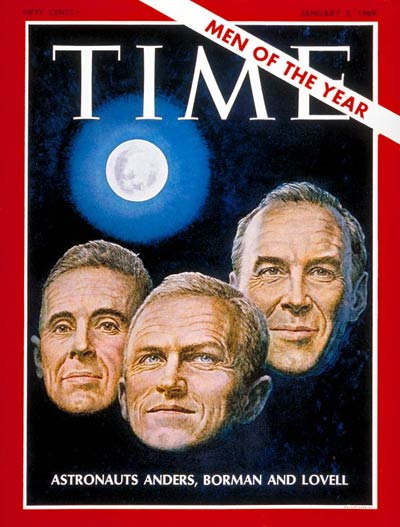
The cover of Time Magazine
Apollo 8 successfully splashed down at 15:51 UTC on December 27 or at exactly 147 hours of flight time. Borman, Lowell, and Anders were noted as the people of the year by Time magazine, and many told them later that they saved the year 1968. And, paradoxically, the first manned flight to the Moon opened for us a new look at the Earth. Happy anniversary of Apollo 8 flight!

Apollo 8 in Moon Orbit, 3D NASA
In dark times

Wounded during the Tet offensive, the American marines, photo by John Olson
1968 from the outset did not ask. In late January, the Vietnam War escalated - the Tet offensive led to the death, according to various sources, of 50-100 thousand people, of whom about 14 thousand were civilians. In March, a massacre took place in the village of Songmi, which will become widely known a year later. In May, the government of Charles de Gaulle resigned as a result of the social crisis in France and the ten-million general strike. In the US, Martin Luther King and Robert Kennedy were killed as a result of the attempted assassination. In August, the USSR sent troops to Czechoslovakia. The Cultural Revolution was ending in China - now they were fighting with the Red Guards.
In the space sphere, matters were also so-so. Both the USA and the USSR were retreating from the catastrophes of 1967, the death of Vladimir Komarov, Gus Grissom, Edward White and Roger Chaffee. On March 27, 1968, a new tragedy occurred - the first cosmonaut Yuri Gagarin died in a training flight. At the same time, the moon race reached its peak. In the first half of the year in the United States conducted unmanned tests of the lunar module (Apollo 5) and the second test of the launch vehicle Saturn V (Apollo 6). The USSR responded in part by successfully launching the Zond-4 unmanned flyby of the moon. In September, the Zond-5 successfully flew around the moon, and there were chances that suddenly Soviet cosmonauts would end up on the trajectory to the moon. NASA needed to do something.
Change of plans

Removal of Apollo 8 at the start, October 1968
According to the original plan, after Apollo unmanned tests, they were to be tested in flight with the crew in near-earth orbit. Further missions depended on the readiness of the lunar module - in the initial plan they wanted to test him first in near-earth orbit, then in elliptical, then in orbit of the moon, and, finally, the next mission was to be landing on the moon. But in the summer of 1968, it turned out that there were more than a hundred bugs in the lunar module, and until next year he could not fly. Therefore, NASA decided to risk and maneuver missions. The tests of the command module in the near-earth orbit, Apollo 7, already scheduled for October, cannot be moved anywhere. If the lunar module is not ready, its manned tests in near-earth orbit (Apollo-9) will have to be shifted. But the next command module was expected as early as December, and it became possible to replace the tests of the lunar module in an elliptical orbit around the Earth with a manned flight to the Moon without a lunar module, but with access to the lunar orbit. In addition to the political goal of overtaking the USSR, this mission was also useful for the test program. So in August 1968 was born "Apollo-8". But one more problem had to be solved.
The second tests of the Apollo-6 launch vehicle did not go very smoothly. In the area of the first stage, longitudinal oscillations (also known as “pogo”) arose; in the second stage, first one and then the second engine was disconnected. Without the elimination of these problems, it was impossible to fly anywhere. By August, hydraulic dampers were added to the design of the first stage, removing vibrations, and in the second stage, the pilot fuel tube was modified and the wires were shortened so that they could not be confused. The changes were successfully tested on the ground and checked in flight on the Apollo 7 in October. You could fly.
The ship and the rocket were assembled in September, brought to launch in October, and fixed minor problems until December.
Forward!

Photo NASA
Now fun to look at the main and reserve crews of the Apollo 8. In the main crew (right) Lowell, Borman and Anders, in the reserve (left) - Armstrong, Aldrin and Hayes. On the Apollo 11, the situation will be reversed - mainly the crew of Armstrong, Aldrin, Collins, in the reserve - Lowell, Anders and Hayes. Fred Haze will then fly to Apollo 13 with Lowell.

NASA Photos
Apollo 8 was launched at 12:51 UTC on December 21, 1968. After a minute, the rocket overcame the speed of sound. According to the astronauts, commander Frank Borman removed his hand from the handle of the manual activation of the emergency rescue system - the rocket shook so that he decided to die rather than cause a false CAC response. However, the start was without comment. After 2 minutes 34 seconds, the first stage began, the second stage worked until 08:44. The third stage engine came on at 08:48 and worked until 11:25. The ship went into orbit. By the end of the second hour of the flight, the ship's systems checked, and at 15:41 UTC (02:50:37 AM) the third stage engine started up again. Five minutes later, the Apollo 8 went to the moon.

NASA Photos
After separation from the third stage, the “full-fledged” Apollo had to turn around and dock with the lunar module. The Apollo-8 had a mass-dimensional mock-up of the lunar module, but this didn’t stop practicing - turn the ship around and take a picture of the third stage with an adapter.

The photo was supposedly taken by Anders.
Having traveled only 10% of the distance to the moon, the astronauts could already feel the main lesson of space - scale. The earth was now located entirely in the porthole, and for the first time, people saw with their own eyes how it was shrinking.
In general, things were going well, but it was not without problems. First of all, the beginning of the nauseous crew commander, Frank Borman. The cosmic adaptation syndrome is a perfectly normal thing, and now about 33-66% of the crew suffers, but, of course, there is a slight panic on the part of the medics. Someone even thought to recall the mission, but the ballistics was inexorable - the Apollo flew to the Moon. Part of the second problem can be seen in the photo of the third step above - the pieces of ice along with other debris pretended to be stars and seriously hampered the work on determining the position of the ship.
Fear and admiration
On December 24, Apollo 8 arrived at the moon. And it was waiting for a new critical operation - the transition to the lunar orbit. According to the laws of ballistics, the maneuver had to be carried out on the far side of the moon, out of sight of the Earth. The ship went behind the disk of the moon, the connection with it disappeared, and the control center held its breath. If the ship appeared earlier, it would mean that he could not perform the maneuver. It would not be scary - "Apollo 8" before the maneuver was on the trajectory of returning to Earth. But every second of delay would be deadly - in the maneuver performed for the first time there was quite a chance in case of an error to crash into the moon. The maneuver was successful. And in the third orbit, astronauts noticed a new beauty - the Earth, which ascended over the lunar horizon. They first made a black and white photo, then frantically rushed to look for a color film.

But the reconstruction, in which the position of the ship in space is restored by automatically taking photographs of a fixed camera.
Christmas
In the lunar orbit, Apollo 8 completed a maneuver to go into a circular orbit of 110 km, the astronauts took many photos, experimented with observing training landing sites, and conducted two more live broadcasts (two were already on the way to the Moon). But the world remembered the fourth broadcast, at 87 hours of flight and 18 hours of being in the Moon’s orbit. Even before the flight, astronauts knew that they would broadcast live from one of the largest audiences in the history of mankind. They asked: "What shall we say?" NASA replied: "Something suitable." The crew thought for a long time, but could not think of anything. Went to friends, journalists and writers, they also could not help. But once the wife of one of his acquaintances asked: "Why don't you start from the beginning?" "What is the beginning?" "The Book of Genesis." And at the end of the broadcast, on Christmas night of 1968, 02:57 UTC on December 25,
After landing on the Bible for astronauts, the well-known American atheist activist Madeleine Murray O'Hare attempted to sue. Courts of various instances refused to accept the case for consideration, but after this story, NASA began to monitor more strictly what was said in the broadcasts.
On the morning of December 25, UTC, or at 90 o'clock, the Apollo-8 mission performed a critical operation without duplication in the event of an accident — turned on the service engine's main engine and accelerated to Earth. The maneuver was also performed on the far side of the moon. And there is nothing surprising that the first words after establishing the connection were “Please note, Santa Claus IS!” The maneuver went well, and it was already possible to joke.
Epilogue

The cover of Time Magazine
Apollo 8 successfully splashed down at 15:51 UTC on December 27 or at exactly 147 hours of flight time. Borman, Lowell, and Anders were noted as the people of the year by Time magazine, and many told them later that they saved the year 1968. And, paradoxically, the first manned flight to the Moon opened for us a new look at the Earth. Happy anniversary of Apollo 8 flight!
